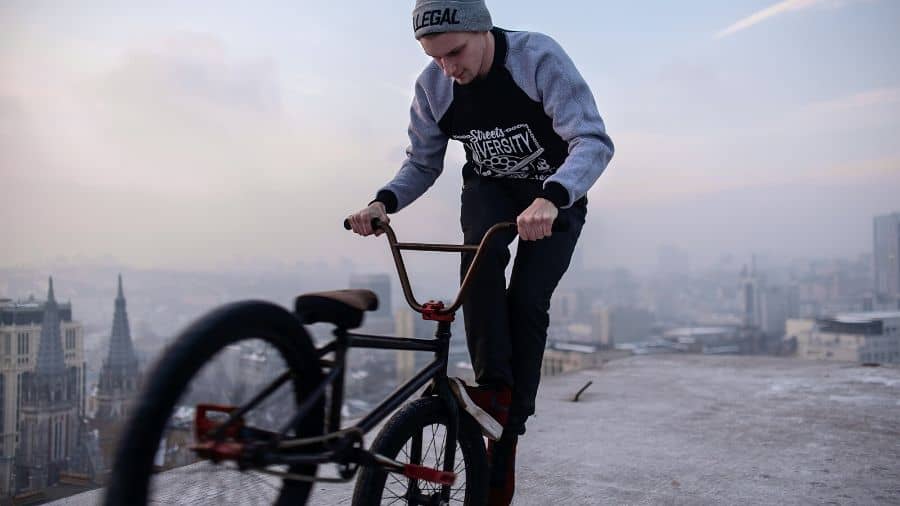
Being able to stop on most bikes is fairly straightforward, a squeeze of the brake lever, and that’s it. But BMX bikes aren’t the same as your regular bike. BMXs are built for stunts and high-speed racing, and whether or not they have or need brakes is not always clear.
Most BMX bikes come with a rear brake only, however, some are fitted with both front and rear, or very rarely, front only. As a safety measure and a requirement for racing, BMX racing bikes are equipped with a rear brake. Some Freestyle BMX riders prefer to remove their brakes in order to perform tricks without the brake cables getting in the way.
As we’ve learned, BMX bikes do in fact have brakes so now we’re going to deep dive into the reasons why and why this isn’t always the case. BMX riders need nerves of steel, weeks and months of practice, and complete control over their BMX bikes, and making use of their bike’s brakes – and sometimes their lack of brakes – successfully aids them in performing their stunts and winning races.
Table of Contents
Why BMX Bikes Have Brakes
As a rule, all new BMX bikes must be sold with brakes in one form or another. In many countries, riding any type of bicycle on public roads without brakes is an illegal action.
In the USA and the United Kingdom, and many parts of Europe, BMXers caught on public roads without brakes can be served with a fine.
According to traffic laws, cyclists must be able to stop in emergency situations, and if their BMX bike’s brakes have been removed it is the fault of the rider involved in an accident.
In the US laws vary from state to state, but in most places, for road use, it says each bike must have a brake that will allow a cyclist to stop one wheel on clean, dry, level pavement.
As a matter of safety, bicycles equipped with brakes are able to stop quickly to avoid crashing. On public roads, where vehicles of all sizes travel in the same direction or on opposite sides of the road, with intersections and junctions, cyclists no matter their cycling discipline and bike type should always bear safety as a top priority in their sport and commuting.
That being said, a freestyle BMX rider that transports their BMX bike to a street or skate park to practice their sport need not adhere to traffic regulations. For these riders, the simplicity of riding without brakes offers them greater freedom in performing stunts and complex techniques, without the need to have to reset their handlebars to unwind the brake cables before attempting the next trick.
How Do Riders Stop their BMX Bikes Without Brakes?
Freestyle BMX riders don’t attain the high speeds of BMX racers, instead favoring control and measured speed to perform their stunts and tricks. A typical freestyle BMX stunt is performed at rolling speeds of 10-15 km/h, whereas BMX sprint at speeds of around 57 km/h.
Those freestyle BMX riders running a brake-less bike use their foot as a brake by planting it onto the rear tire to slow down their speed. While this method isn’t recommended for slowing down on public roads with traffic, in a skate or street park’s secure environment it is a trend within the freestyle sport.
What Brakes do BMX Bikes Have
BMX bike brakes come in two types: V-brakes and U-brakes. Both are controlled by a hand lever mounted on the handlebar. BMX racing bikes are fitted with what are called linear or V-brakes mounted to their rear rims. Apart from being far lighter than U-brakes, V-brakes are also more powerful.
How do BMX Brakes Work?
The two BMX bike brake systems offer the same purpose, but through their design, they operate in different ways on different types of BMX bikes.
V-brakes on BMX racing bikes loop over the edge of the bike’s rim with rubber pads positioned a few millimeters on each side of the rim. V-brakes, as with all BMX bike brakes, are cable-actuated, with the cable routing along the bike’s frame from the handlebar lever. When pulling the brake lever, V-brakes are designed to pull more cable and thereby provide a more powerful grip on the rim – and better modulation of the brake’s force – for a better stopping experience.
U-brakes The most common type of BMX bike brake system is the U-brake. These are standard fit on all Freestyle and Flatlands BMX bikes thanks to their durability, simple design and their cable routing.
Through clever cable routing, what is called a Gyro headset, riders are able to perform 180- and 360-degree handlebar spins and tailwhips. This invention is usually only used for the bike’s rear brake. It works by routing the brake cable through the stem with a hollow stem bolt to the fork steerer tube and then along the frame to the brakes. This ingeniously avoids the tangling problem.
How do Brake Pads Work?
BMX brake pads, as small as they are in size and simple in design, provide excellent stopping power. They are manufactured from different rubber compounds, for enhanced performance and lighter weight, to be more durable, or offer improved wet-weather power.
The life of a BMX brake pad is determined by the rubber compound: options include soft compounds for greater stopping power, but their durability is limited; dual compound rubber pads for consistent braking performance and feel for both wet and dry weather riding; and, hard compounds that offer extended brake pad life but suffer in brake pad performance.
To further improve the performance and longevity of BMX bike brake pads, designers have extended their length, offering not only a greater surface for gripping the rim but also for even pad wear. Brake pads also feature grooves to better dispel water from the rim to enhance braking force.
Brake pads come in a variety of colors, from black to camo-inspired designs and even clear. For BMX bike riders with anodised rims, the clear brake pads help to preserve the color and finish of their rims.
Do BMX Bikes Have Pedal Brakes?
For youngsters setting out to learn bicycle riding, the most popular first bike is a BMX bike. For these mini-micro- and micro-sized BMX bikes for riders 7 years old and younger, a coaster brake is fitted as standard.
A coaster brake allows children the ability to learn balance and the fundamentals of bicycle control and to make it easier the coaster brake allows the BMX bike to roll forwards without rotating the pedals and crank. This is due to a special rear hub.
This hub, called a coaster hub, also operates as brakes for the rider and BMX bike, functioning when the cranks are pedaled in reverse direction. Coaster hubs contain internal brake shoes housed in a metal shell.
When rotating the pedals backwards, these brake shoes then expand and thereby slow the bike’s speed. For youngsters, this is the by far the most efficient and easiest way to slow speed; their small hands are simply not strong enough to sufficiently pull the brake lever.
My Favourite BMX Brake Products
- Tektro 984 BMX Caliper Brakes (Amazon Link)
- Dia Compe Goldfinger BMX Bike Brake Lever Right Gold (Amazon Link)
- Tektro 930AL BMX V-Brake with Lever, Black (Amazon Link)
